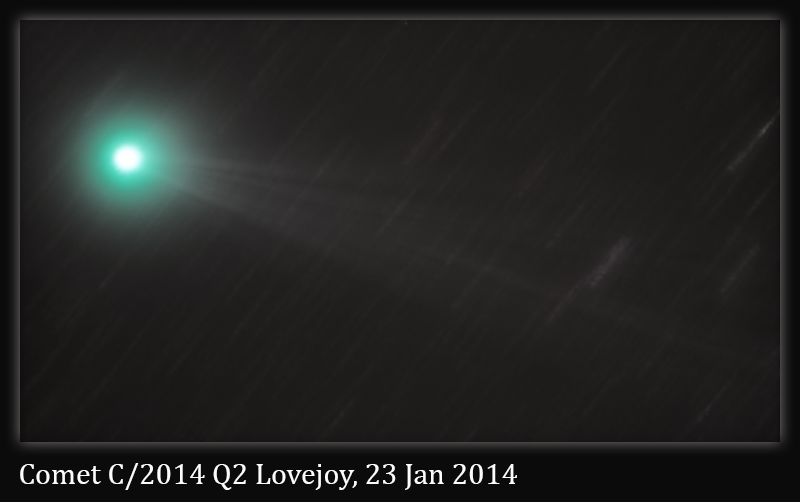Transits and shadow transits occur frequently. I use the "JupiterMoons" app from Sky and Telescope to find out about them. But last Friday night was special, because it was one of the rare times when the shadows of 3 of Jupiter's big Galilean moons were simultaneously visible transiting the disk of the planet. These "triple shadow transits" happen roughly once in a decade; I believe the next one will not occur for another 17 years. Luckily, two good things happened last Friday: I saw a reminder of the triple shadow transit that afternoon, and the weather here was clear. So even though I'm not very skilled at lunar/planetary data acquisition or processing, I decided this was something I could not pass up.
I used a $30 Logitech c270 HD webcam as my imager. It has fairly small pixels (I believe they are 2.8 microns square) and has reasonably high data transfer rates with a USB2 interface. I modified it to fit my focuser by removing the lens on the front and replacing it with a 1.25" adapter (I just hot glued the adapter onto the camera). I did all this many months ago, so I have some experience using the camera. I use a 3x Meade Barlow lens to get a more magnified image than I could get with just the 800 mm native focal length of my AT8IN newtonian telescope; this puts me at 2400 mm focal length (still not great for planetary work, but the best I can do with my equipment). I had wanted to use SharpCap to control my imaging session, but as Jupiter rose above the mountains to my east I could not get VMWare/Windows 7 to recognize the camera. I was able to see it fine via Mac OSX 10.10.1, so rather than waste time fighting the software I decided to go with the Mac software I have, imaging with BTV and controlling the camera settings with WebCam Settings.
The next challenge was getting focused and getting Jupiter into the field of view. I focused by finding a nearby streetlight, figuring that would get me close enough, and it did. Then I took an image through my guide scope and plate solved with Astrotorilla, then used the PicGoto to slew to Jupiter's coordinates, obtained from Astroplanner. This got Jupiter into my guide scope field of view, but not into the imager (my guide scope was only roughly aligned). From there I just slewed around until I got lucky. I focused and started imaging.
The goal when shooting Jupiter is to get as many frames as possible so that your software (Registax in my case) can find the few where the seeing is good and stack them. At first I used the full field of view of the camera (1280 x 800, if I remember correctly) and 2 minute videos. This leaves lots of wasted black space around Jupiter and makes the data transfers (and the frame rate) relatively slow, so I cut back to 640 x 480 to make the videos smaller and improve the frame rate. In retrospect, I probably should have cut down even more to improve my frame rate further. I had intended to just make one long video and cut it into 2 minute segments for processing and stacking, but BTV apparently is limited to 3 minutes so I went with that and refocused every 3 minutes. This is a little too long because the planet's rotation is reported to blur images using more than about 2 minutes' worth of data, but I went with it. Seeing wasn't great so focusing was hard, and this is obvious in some of my stacked data.
After Registax processing using automatic alignpoints and 75 best frames per alignpoint, followed by wavelet sharpening, I got a series of frames that I combined using Photoshop CC 2014. I took a lot of time adding in timestamps for the various frames. Here's the result. It’s interesting that it is possible to see Europa’s disk (not the shadow, the actual disk) entering transit and Io’s leaving (both happen at about the same time, at about 00:06-00:010). It is also interesting to observe the relative speeds that the shadows move across Jupiter. At the beginning of the session, the shadows of Io and Callisto overlap near the center of the image, but Io's moves off quickly, reflecting the fact that Io is the innermost Galilean and so its orbital speed is high. Likewise, Europa's shadow (entering from the right of the image) moves more quickly than Callisto's because Europa is the 2nd closest Galilean to Jupiter whereas Callisto is the outmost big moon.
Despite my less-than-stellar planetary astrophotography skills, I couldn’t pass up a chance to image the triple shadow transit. Seeing was variable, but in the best images such as the title frame the detail was reasonable given my equipment and skill level. It’s interesting that it is possible to see Europa’s disk (not the shadow, the actual disk) entering transit and Io’s leaving (both happen at about the same time, at about 00:06-00:010). I would have liked to use SharpCap to control this session, but I couldn’t get VMWare/Win 7 to recognize the Logitech webcam, whereas MacOS was seeing it so I went with the MacOS solution.
Date: 23 Jan 2015
Subject: Jupiter triple shadow transit
Scope: AT8IN, 3x Barlow(f/12, 2400 mm)
Mount: CG-5
Guiding: PHD2 (on a star)
Camera: Logitech c270 HD at 640 x 480
Acquisition: BTV+WebCam Settings
Exposure: 180 sec, ~15 fps mov
Stacking: Registax 6, automatic alignpoint selection, best 75 frames/alignpoint
Processing: Registax 6 wavelets, CS6 combine into animated GIF






